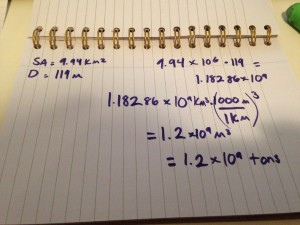Concept: someone, who is obviously very magical (either with a top hat and a small black wand or a giant, pointy hat with stars on it and the most magnificent beard anyone has ever seen) pours water into a cup. The audience can clearly see the water going into the cup, can almost see the water inside the cup, yet when the magician turns the cup over, no water comes out. The magician then tells the audience the water did not come out because it’s gone (“POOF!”) into another dimension. Someone somewhere has probably just been drenched in approximately 50 mL of water. Everyone laughs.
It’s a pretty strange concept. It’s impossible to make water just disappear – sure, it can change into a gas if heated, but the water disappeared almost instantly. There wasn’t any time for this magician to heat all the water up so that it disappeared, so where did it go?
Someone who is not scientifically inclined may say that the concept illustrated in the first paragraph is entirely fictional, but those who care about the events of the world at an atomic level know that that’s not true. Magic can be found in the simplest of places – in this case, diapers.
The sort of powder that is found in lining of diapers is called sodium polyacrylate, more commonly known as polymer powder. It’s an anionic polyelectrolyte, and is highly hygroscopic, meaning it can absorb a lot of water. In the case of sodium polyacrylate (-CH2-CH(CO2Na)), it can absorb up to 300 times its weight in water. When it comes into contact with the water, the polymer powder uses osmotic pressure to absorb all the water, so the water mixes with the powder, and the powder expands, taking the water with it. It then makes the water take on a gel consistency, as demonstrated in the video.
In the video, only enough sodium polyacrylate to cover the bottom of the cup was used, and we poured about 30 millilitres in, enough to fill a quarter of the cup. Within about three to five seconds, all of the water was gel.
We encountered this trick via lots of research into chemistry-based magic tricks. Apparently, it’s quite popular, which makes sense. We can’t be the only ones who have ever wondered how baby diapers never leak!
This amazing, beautiful, astounding project was accomplished by the dazzling expertise of Sara Parker and Logan Willis. Because we’re awesome.
Sources:
http://nobel.scas.bcit.ca/debeck_pt/science/diaperAbsorber/diaper_p1.htm
https://en.wikipedia.org/wiki/Sodium_polyacrylate
Note:
In our research, we found a way to build a death ray out of a microwave. So we didn’t do that project, for fear of being contacted by the RCMP or any other investigative organizations that think death ray building is dangerous, especially when done by two sophomores.


